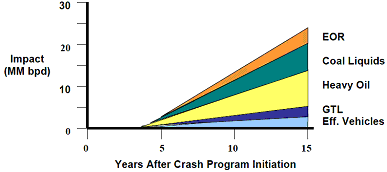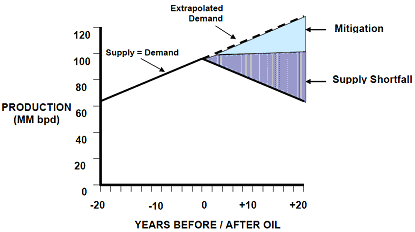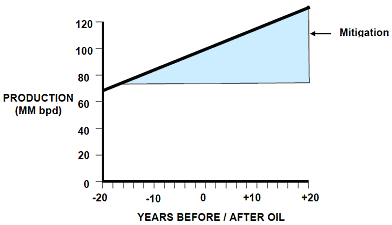Hirsch,R.L., Bezdek,R. and Wendling,R.(2005):
Peaking
of world oil production: Impacts, mitigation, & risk management.
Prepared as an account of work sponsored by an agency of the United
States Government. February 2005.《Hirsch
Reportと呼ばれる》
『世界石油生産がピークに達する:インパクト、ミティゲーション、そしてリスクマネジメント』
『Executive summary
The peaking of world oil production presents the U.S. and the
world with an unprecedented risk management problem. As peaking
is approached, liquid fuel prices and price volatility will increase
dramatically, and, without timely mitigation, the economic, social,
and political costs will be unprecedented. Viable mitigation options
exist on both the supply and demand sides, but to have substantial
impact, they must be initiated more than a decade in advance of
peaking.
In 2003, the world consumed just under 80 million barrels per
day (MM bpd) of oil. U.S. consumption was almost 20 MMbpd, two-thirds
of which was in the transportation sector. The U.S. has a fleet
of about 210 million automobiles and light trucks (vans, pick-ups,
and SUVs). The average age of U.S. automobiles is nine years.
Under normal conditions, replacement of only half the automobile
fleet will require 10-15 years. The average age of light trucks
is seven years. Under normal conditions, replacement of one-half
of the stock of light trucks will require 9-14 years. While significant
improvements in fuel efficiency are possible in automobiles are
light trucks, any affordable approach to upgrading will be inherently
time-consuming, requiring more than a decade to achieve significant
overall fuel efficiency improvement
Besides further oil exploration, there are commercial options
for increasing world oil supply and for the production of substitute
liquid fuels:
1) Improved Oil Recovery (IOR) can marginally increase production
from existing reservoirs; one of the largest of the IOR opportunities
is Enhanced Oil Recovery (EOR), which can help moderate oil production
declines from reservoirs that are past their peak production:
2) Heavy oil/oil sands represents a large resource of lower grade
oils, now primarily produced in Canada and Venezuela; those resource
are capable of significant production increases;.
3) Coal liquefaction is a well-established technique for producing
clean substitute fuels from the world's abundant coal reserves;
and finally,
4) Clean substitute fuels can be produced from remotely located
natural gas, but exploitation must compete with the world's growing
demand for liquefied natural gas.
However, world-scale contributions from these options will require
10-20 years of accelerated effort.
Dealing with world oil production peaking will be extremely complex,
involve literally trillions of dollars and require many years
of intense effort. To explore these complexities, three alternative
mitigation scenarios were analyzed:
- Scenario I assumed that action is not initiated until
peaking occurs.
- Scenario II assumed that action is initiated 10 years
before peaking.
- Scenario III assumed action is initiated 20 years before
peaking.
For this analysis estimates of the possible contributions of
each mitigation option were developed, based on an assumed crash
program rate of implementation. Our approach was simplified in
order to provide transparency and promote understanding. Our estimates
are approximate, but the mitigation envelope that results is believed
to be directionally indicative of the realities of such an enormous
undertaking. The inescapable conclusion is that more than a decade
will be required for the collective contributions to produce results
that significantly impact world supply and demand for liquid fuels.
Important observations and conclusions from this study are as
follows:
- When world oil peaking will occur is not known with certainty.
A fundamental problem in predicting oil peaking is the poor quality
of and possible political biases in world oil reserves data.
Some experts believe peaking may occur soon. This study indicates
that “soon” is within 20 years.
- The problems associated with world oil production peaking
will not be temporary, and past “energy crisis” experience will
provide relatively little guidance. The challenge of oil peaking
deserves immediate, serious attention, if risks are to be fully
understood and mitigation begun on a timely basis.
- Oil peaking will create a severe liquid fuels problem for
the transportation sector, not an “energy crisis” in the usual
sense that term has been used.
- Peaking will result in dramatically higher oil prices, which
will cause protracted economic hardship in the United States
and the world. However, the problems are not insoluble. Timely,
aggressive mitigation initiatives addressing both the supply
and the demand sides of the issue will be required.
- In the developed nations, the problems will be especially
serious. In the developing nations peaking problems have the
potential to be much worse.
- Mitigation will require a minimum of a decade of intense,
expensive effort, because the scale of liquid fuels mitigation
is inherently extremely large.
- While greater end-use efficiency is essential, increased
efficiency alone will be neither sufficient nor timely enough
to solve the problem. Production of large amounts of substitute
liquid fuels will be required. A number of commercial or near-commercial
substitute fuel production technologies are currently available
for deployment, so the production of vast amounts of substitute
liquid fuels is feasible with existing technology.
- Intervention by governments will be required, because the
economic and social implications oil peaking would otherwise
be chaotic. The experiences of the 1970s and 1980s offer important
guides as to government actions that are desirable and those
that are undesirable, but the process will not be easy.
Mitigating the peaking of world conventional oil production
presents a classic risk management problem:
- Mitigation initiated earlier than required may turn out to
be premature, if peaking is long delayed.
- If peaking is imminent, failure to initiate timely mitigation
could be extremely damaging.
Prudent risk management requires the planning and implementation
of mitigation well before peaking. Early mitigation will almost
certainly be less expensive than delayed mitigation. A unique
aspect of the world oil peaking problem is that its timing is
uncertain, because of inadequate and potentially biased reserves
data from elsewhere around the world. In addition, the onset of
peaking may be obscured by the volatile nature of oil prices.
Since the potential economic impact of peaking is immense and
the uncertainties relating to all facets of the problem are large,
detailed quantitative studies to address the uncertainties and
to explore mitigation strategies are a critical need.
The purpose of this analysis was to identify the critical issues
surrounding the occurrence and mitigation of world oil production
peaking. We simplified many of the complexities in an effort to
provide a transparent analysis. Nevertheless, our study is neither
simple nor brief. We recognize that when oil prices escalate dramatically,
there will be demand and economic impacts that will alter our
simplified assumptions. Consideration of those feedbacks will
be a daunting task but one that should be undertaken.
Our study required that we make a number of assumption and estimates.
We well recognize that in-depth analyses may yield different numbers.
Nevertheless, this analysis clearly demonstrates that the key
to mitigation of world oil production peaking will be the construction
a large number of substitute fuel production facilities, coupled
to significant increases in transportation fuel efficiency. The
time required to mitigate world oil production peaking is measured
on a decade time-scale. Related production facility size is large
and capital intensive. How and when governments decide to address
these challenges is ye to be determined.
Our focus on existing commercial and near-commercial mitigation
technologies illustrates that a number of technologies are currently
ready for immediate and extensive implementation. Our analysis
was not meant to be limiting. We believe that future research
will provide additional mitigation options, some possibly superior
to those we considered. Indeed, it would be appropriate to greatly
accelerate public and private oil peaking mitigation research.
However, the reader must recognize that doing the research required
to bring new technologies to commercial readiness takes time under
the best of circumstances. Thereafter, more than a decade of intense
implementation will be required for world scale impact, because
of the inherently large scale of world oil consumption.
In summary, the problem of the peaking of world conventional
oil production is unlike any yet faced by modern industrial society.
The challenges and uncertainties need to be much better understood.
Technologies exist to mitigate the problem. Timely, aggressive
risk management will be essential.』
I. Introduction
II. Peaking of world oil production
A. Background
B. Oil reserves
C. Production peaking
D. Types of oil
E. Oil resources
F. Impact of higher prices and new technology
G. Projections of the peaking of world oil production
III. Why the transition will be so time consuming
A. Introduction
B. Historical U.S. oil consumption patterns
C. Petroleum in the current U.S. economy
D. Capital stock characteristics in the largest consuming sectors
E. Consumption outside the U.S.
F. Transition conclusions
IV. Lessons and implications from previous oil supply disruptions
A. Previous oil supply shortfall and disruptions
B. Difficulties in deriving implications from past experience
C. How oil supply shortfalls affect the global economy
D. The U.S. experience
E. The experience of other countries
1. The developed (OECD) economies
2. Developing countries
F. Implications
1. The world economy
2. The United States
V. Learning from the natural gas experience
A. Introduction
B. The optimism
C. Today's perspectives
D. U.S. natural gas price history
E. LNG - delayed salvation
F. The U.S. current natural gas situation
G. Lessons learned
VI. Mitigation options and issues
A. Conservation
B.Improved oil recovery
C. Heavy oil and oil sands
D. Gas-to-liquids (GTL)
E. Liquid fuels from U.S. domestic resources
F. Fuel switching to electricity
G. Other fuel switching
H. Hydrogen
I. Factors that can cause delay
VII. A world problem
VIII. Three mitigation scenarios
A. Introduction
B. Mitigation options
C. Mitigation phase-in
D. The use of wedges
E. criteria for wedge selection
F. Wedges selected & rejected
G. Modeling world oil supply/demand
H. Our wedges
I. The three scenarios
J. Observations & conclusions on scenarios
K. Risk management
IX. Market signals as peaking is approached
X. Wildcards
A. Upsides - things that might ease the problem of world
oil peaking
B. Downsides - things that might exacerbate the problem of world
oil peaking
XI. Summary and concluding remarks
1. World oil peaking is going to happen
2. Oil peaking could cost the U.S. economy dearly
3. Oil peaking presents a unique challenge
4. The problem is liquid fuels
5. Mitigation efforts will require substantial time
6. Both supply and demand will require attention
7. It is a matter of risk management
8. Government intervention will be required
9. Economic upheaval is not inevitable
10. More information is needed
Acknowledgements
Appendix I. Most meaningful EIA oil peaking case
Appendix II. More historical oil crisis considerations
Appendix III. Likely future oil demand
Appendix IV. Rationales for the wedges
A. Vehicle fuel efficiency
Saving in the U.S.
Worldwide savings
B. Coal liquids
C. Heavy oils/oil sands
D. Enhanced oil recovery
E. Gas-to-liquids
F. Sum of the wedges
Appendix V. Notes on shale oil and biomass
A. Oil shale by Gilbert McGurl, NETL
B. Biofuels by Peter Balash, NETL
Appendix VI. Areas for further study
1. Economic benefits to the U.S. associated with an aggressive
mitigation initiative
2. Oil peaking risk analysis: cost of premature mitigation versus
waiting
3. U.S. natural gas production as a paradigm for viewing world
oil peaking
4. Potential for non-transportation oil fuel-switching
5. World coal-to-liquids potential
6. World heavy oil/oil sands potential
7. World EOR potential
8. World GTL potential
9. World transportation fuel efficiency improvement potential
10. Impacts of oil prices and technology on U.S. lower 48 oil
production
11. Technological options for coal liquefaction
12. Performance of oil provinces outside of the U.S.
13. How the U.S. could again become the world's largest oil producer
14. Market signals in advance of peaking
15. Risk of repeating the synthetic fuels experience of 1970s
and 1980s
16. Effects of oil price spikes in causing U.S. recessions
Table II-1. Projections of the Peaking of World
Oil Production
|
Projected Date |
Source of Projection |
Background & Reference |
|
2006-2007 |
Bakhitari, A.M.S. |
Iranian Oil Executive11 |
|
2007-2009 |
Simmons, M.R. |
Investment banker12 |
|
After 2007 |
Skrebowski, C. |
Petroleum journal Editor13 |
|
Before 2009 |
Deffeyes, K.S. |
Oil company geologist (ret.)14 |
|
Before 2010 |
Goodstein, D. |
Vice Provost, Cal Tech15 |
|
Around 2010 |
Campbell, C.J. |
Oil company geologist (ret.)16 |
|
After 2010 |
World Energy Council |
World Non-Government Org.17 |
|
2010-2020 |
Laherrere, J. |
Oil company geologist (ret.)18 |
|
2016 |
EIA nominal case |
DOE analysis/ information19 |
|
After 2020 |
CERA |
Energy consultants20 |
|
2025 or later |
Shell |
Major oil company21 |
|
No visible peak |
Lynch, M.C. |
Energy economist22 |
11Bakhtiari, A.M.S. "World Oil
Production Capacity Model Suggests Output Peak by 2006-07."
OGJ. April 26, 2004.
12Simmons, M.R. ASPO Workshop. May 26, 2003.
13Skrebowski, C. "Oil Field Mega Projects - 2004."
Petroleum Review. January 2004.
14Deffeyes, K.S. Hubbert's Peak-The Impending World
Oil Shortage. Princeton University Press. 2003.
15Goodstein, D. Out of Gas - The End of the Age of
Oil. W.W. Norton. 2004
16Campbell, C.J. "Industry Urged to Watch for
Regular Oil Production Peaks, Depletion Signals." OGJ. July
14, 2003.
17Drivers of the Energy Scene. World Energy Council.
2003.
18Laherrere, J. Seminar Center of Energy Conversion.
Zurich. May 7, 2003
19DOE EIA. "Long Term World Oil Supply."
April 18, 2000. See Appendix I for discussion.
20Jackson, P. et al. "Triple Witching Hour for
Oil Arrives Early in 2004 - But, As Yet, No Real Witches."
CERA Alert. April 7, 2004.
21Davis, G. "Meeting Future Energy Needs."
The Bridge. National Academies Press. Summer 2003.
22Lynch, M.C. "Petroleum Resources Pessimism
Debunked in Hubbert Model and Hubbert Modelers' Assessment."
Oil and Gas Journal, July 14, 2003. |
〔Hirsch,R.L., Bezdek,R. and Wendling,R.による(Feb., 2005)Peaking
of World Oil Production: Impacts, Mitigation, & Risk Managementから〕 |
|
H. Our Wedges
In Appendix IV we develop the sizes of the wedges that we believe
appropriate for our trends analysis. The categories, delays and
10-year estimated impacts are shown in Figure VIII-3. Once again,
bear in mind that these are rough
approximations aimed at illustrating the inherently large scale
of mitigation.

Figure VIII-3. Assumed wedges
〔Hirsch,R.L., Bezdek,R. and Wendling,R.(2005): Peaking
of world oil production: Impacts, mitigation, & risk management.
Prepared as an account of work sponsored by an agency of the
United States Government. February 2005.《Hirsch
Reportと呼ばれる》から〕 |
|
I. The Three Scenarios
As noted, our three scenarios are benchmarked to the unknown
date of peaking:
. Scenario I: Mitigation begins at the time of peaking;
. Scenario II: Mitigation starts 10 years before peaking;
. Scenario III: Mitigation starts 20 years before peaking.
Our mitigation choices then map onto our assumed world oil peaking
pattern as shown in Figures VIII-4, 5 and 6.

Figure VIII-4. Mitigation crash programs started at
the time of world oil peaking: A significant supply shortfall
occurs over the forecast period.

Figure VIII-5. Mitigation crash programs started 10
years before world oil peaking: A moderate supply shortfall occurs
after roughly 10 years.

Figure VIII-6. Mitigation crash programs started 20
years before world oil peaking: No supply shortfall occurs during
the forecast period.
〔Hirsch,R.L., Bezdek,R. and Wendling,R.(2005): Peaking
of world oil production: Impacts, mitigation, & risk management.
Prepared as an account of work sponsored by an agency of the
United States Government. February 2005.《Hirsch
Reportと呼ばれる》から〕 |
戻る



